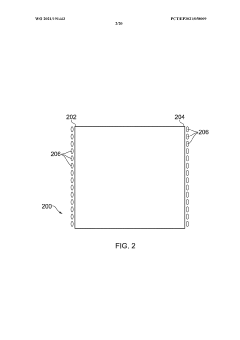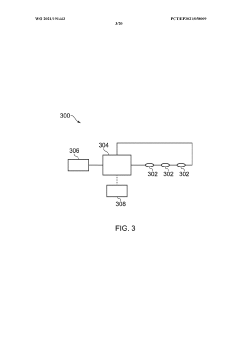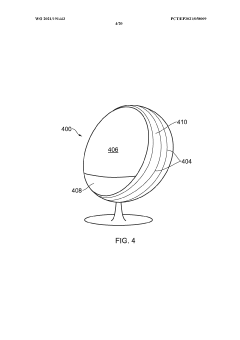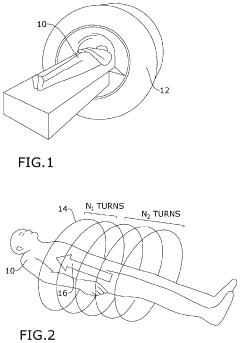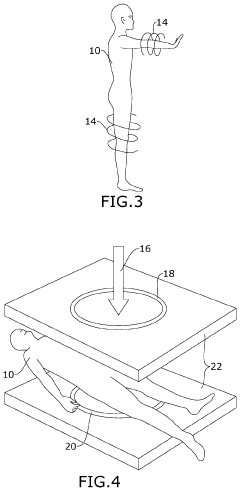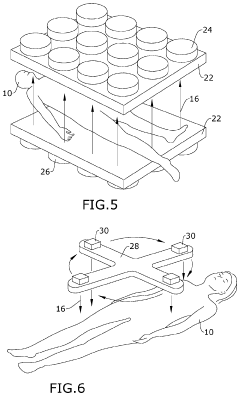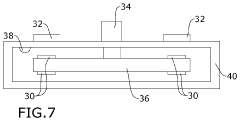Schumann Resonance: Implications for Earth’s Natural Systems
JUN 24, 20259 MIN READ
Generate Your Research Report Instantly with AI Agent
Patsnap Eureka helps you evaluate technical feasibility & market potential.
Schumann Resonance Background and Objectives
The Schumann resonance, discovered by physicist Winfried Otto Schumann in 1952, is a set of spectrum peaks in the extremely low frequency (ELF) portion of the Earth's electromagnetic field spectrum. These resonances occur between the Earth's surface and the ionosphere, creating a global electromagnetic resonance phenomenon. The primary frequency of the Schumann resonance is approximately 7.83 Hz, with harmonics at higher frequencies.
The study of Schumann resonances has evolved significantly since its discovery, with researchers exploring its implications for various Earth systems and potential applications. Initially considered a curiosity in atmospheric science, the Schumann resonance has gained importance in understanding the complex interactions between the Earth's surface, atmosphere, and near-space environment.
The primary objective of researching Schumann resonances is to gain deeper insights into the Earth's electromagnetic environment and its potential impacts on natural systems. This includes investigating the resonance's role in weather patterns, climate dynamics, and even biological processes. Scientists aim to understand how these resonances may influence or be influenced by changes in the Earth's atmosphere, ionosphere, and magnetosphere.
Another key goal is to explore the potential use of Schumann resonances as a tool for monitoring global climate change and extreme weather events. Researchers hypothesize that variations in the resonance frequencies and amplitudes may correlate with large-scale atmospheric and ionospheric disturbances, potentially serving as an early warning system for severe weather or seismic activity.
In recent years, there has been growing interest in the possible biological effects of Schumann resonances. Some studies suggest that these natural electromagnetic frequencies may play a role in regulating circadian rhythms and other physiological processes in living organisms. This has led to investigations into the potential health implications of long-term exposure to environments lacking these natural frequencies, such as space stations or underground facilities.
The technological applications of Schumann resonance research are also expanding. Engineers are exploring ways to harness this phenomenon for long-range communication systems, particularly in situations where traditional radio communication is challenging or impossible. Additionally, there is interest in using Schumann resonance monitoring as a method for detecting underground nuclear tests or other large-scale anthropogenic disturbances to the Earth's electromagnetic field.
As research in this field progresses, scientists aim to develop more sophisticated models of the Earth-ionosphere cavity and improve measurement techniques to better understand the subtle variations in Schumann resonances. This ongoing work promises to enhance our understanding of the Earth's natural systems and their complex interrelationships, potentially leading to new insights in fields ranging from geophysics to biology and telecommunications.
The study of Schumann resonances has evolved significantly since its discovery, with researchers exploring its implications for various Earth systems and potential applications. Initially considered a curiosity in atmospheric science, the Schumann resonance has gained importance in understanding the complex interactions between the Earth's surface, atmosphere, and near-space environment.
The primary objective of researching Schumann resonances is to gain deeper insights into the Earth's electromagnetic environment and its potential impacts on natural systems. This includes investigating the resonance's role in weather patterns, climate dynamics, and even biological processes. Scientists aim to understand how these resonances may influence or be influenced by changes in the Earth's atmosphere, ionosphere, and magnetosphere.
Another key goal is to explore the potential use of Schumann resonances as a tool for monitoring global climate change and extreme weather events. Researchers hypothesize that variations in the resonance frequencies and amplitudes may correlate with large-scale atmospheric and ionospheric disturbances, potentially serving as an early warning system for severe weather or seismic activity.
In recent years, there has been growing interest in the possible biological effects of Schumann resonances. Some studies suggest that these natural electromagnetic frequencies may play a role in regulating circadian rhythms and other physiological processes in living organisms. This has led to investigations into the potential health implications of long-term exposure to environments lacking these natural frequencies, such as space stations or underground facilities.
The technological applications of Schumann resonance research are also expanding. Engineers are exploring ways to harness this phenomenon for long-range communication systems, particularly in situations where traditional radio communication is challenging or impossible. Additionally, there is interest in using Schumann resonance monitoring as a method for detecting underground nuclear tests or other large-scale anthropogenic disturbances to the Earth's electromagnetic field.
As research in this field progresses, scientists aim to develop more sophisticated models of the Earth-ionosphere cavity and improve measurement techniques to better understand the subtle variations in Schumann resonances. This ongoing work promises to enhance our understanding of the Earth's natural systems and their complex interrelationships, potentially leading to new insights in fields ranging from geophysics to biology and telecommunications.
Earth System Applications and Demand
The Schumann Resonance, a set of spectral peaks in the Earth's electromagnetic field spectrum, has garnered significant attention in various Earth system applications. This natural phenomenon, discovered by Winfried Otto Schumann in 1952, has implications for understanding and monitoring global climate patterns, atmospheric dynamics, and even potential earthquake prediction.
In meteorology and climate science, there is a growing demand for utilizing Schumann Resonance data to enhance weather forecasting models. The resonance's sensitivity to global lightning activity provides valuable insights into atmospheric convection patterns and tropical storm development. Researchers are exploring how variations in Schumann Resonance frequencies correlate with large-scale weather phenomena, potentially improving long-term climate predictions and our understanding of climate change impacts.
The field of atmospheric science has shown increased interest in Schumann Resonance as a tool for studying the ionosphere and its interactions with the lower atmosphere. This application is particularly relevant for investigating space weather effects and their influence on Earth's communication systems. As our reliance on satellite-based technologies grows, the demand for accurate ionospheric monitoring tools, including Schumann Resonance measurements, is expected to rise.
In the realm of geophysics, Schumann Resonance observations are being explored for their potential in earthquake prediction and monitoring. Some studies suggest that changes in the resonance patterns may precede seismic events, although this relationship remains controversial and requires further research. The non-invasive nature of Schumann Resonance monitoring makes it an attractive option for continuous global seismic risk assessment.
Environmental scientists are increasingly interested in using Schumann Resonance data to study global environmental changes. The resonance's sensitivity to the Earth's surface-ionosphere cavity properties makes it a potential indicator of large-scale environmental shifts, including changes in global temperature, sea level, and atmospheric composition. This application could provide a unique, global perspective on environmental changes that complement traditional monitoring methods.
The medical and biological research communities have also shown interest in Schumann Resonance, particularly in studying its potential effects on human health and circadian rhythms. While the direct impact of Schumann Resonance on biological systems remains a subject of debate, there is a growing demand for research to explore potential applications in chronobiology and environmental medicine.
As awareness of Schumann Resonance and its potential applications grows, there is an increasing demand for more sophisticated monitoring networks and data analysis techniques. This includes the development of high-sensitivity magnetometers, advanced signal processing algorithms, and global data sharing initiatives to fully leverage the information contained in these natural electromagnetic oscillations.
In meteorology and climate science, there is a growing demand for utilizing Schumann Resonance data to enhance weather forecasting models. The resonance's sensitivity to global lightning activity provides valuable insights into atmospheric convection patterns and tropical storm development. Researchers are exploring how variations in Schumann Resonance frequencies correlate with large-scale weather phenomena, potentially improving long-term climate predictions and our understanding of climate change impacts.
The field of atmospheric science has shown increased interest in Schumann Resonance as a tool for studying the ionosphere and its interactions with the lower atmosphere. This application is particularly relevant for investigating space weather effects and their influence on Earth's communication systems. As our reliance on satellite-based technologies grows, the demand for accurate ionospheric monitoring tools, including Schumann Resonance measurements, is expected to rise.
In the realm of geophysics, Schumann Resonance observations are being explored for their potential in earthquake prediction and monitoring. Some studies suggest that changes in the resonance patterns may precede seismic events, although this relationship remains controversial and requires further research. The non-invasive nature of Schumann Resonance monitoring makes it an attractive option for continuous global seismic risk assessment.
Environmental scientists are increasingly interested in using Schumann Resonance data to study global environmental changes. The resonance's sensitivity to the Earth's surface-ionosphere cavity properties makes it a potential indicator of large-scale environmental shifts, including changes in global temperature, sea level, and atmospheric composition. This application could provide a unique, global perspective on environmental changes that complement traditional monitoring methods.
The medical and biological research communities have also shown interest in Schumann Resonance, particularly in studying its potential effects on human health and circadian rhythms. While the direct impact of Schumann Resonance on biological systems remains a subject of debate, there is a growing demand for research to explore potential applications in chronobiology and environmental medicine.
As awareness of Schumann Resonance and its potential applications grows, there is an increasing demand for more sophisticated monitoring networks and data analysis techniques. This includes the development of high-sensitivity magnetometers, advanced signal processing algorithms, and global data sharing initiatives to fully leverage the information contained in these natural electromagnetic oscillations.
Current State and Challenges in SR Research
Schumann Resonance (SR) research has made significant strides in recent years, yet it continues to face several challenges. The current state of SR research is characterized by a growing understanding of its potential implications for Earth's natural systems, but also by limitations in measurement techniques and data interpretation.
One of the primary advancements in SR research has been the establishment of a global network of SR monitoring stations. These stations have enabled researchers to collect continuous data on SR frequencies and intensities, providing valuable insights into global electromagnetic phenomena. However, the distribution of these stations remains uneven, with a concentration in developed countries and limited coverage in remote areas.
The development of more sensitive and accurate measurement equipment has improved the quality of SR data. Modern magnetometers and electric field sensors can now detect subtle variations in SR parameters, allowing for more precise analysis of their relationships with various geophysical and atmospheric processes. Nevertheless, challenges persist in distinguishing SR signals from other electromagnetic noise, particularly in urban environments.
Data analysis techniques have also evolved, with the application of advanced signal processing algorithms and machine learning methods. These tools have enhanced researchers' ability to extract meaningful information from SR measurements and identify correlations with other environmental variables. However, the complexity of Earth's electromagnetic environment often makes it difficult to establish clear causal relationships.
A significant challenge in SR research is the multidisciplinary nature of its implications. While SR phenomena are rooted in atmospheric physics, their potential effects span across fields such as biology, climate science, and even human health. This breadth requires collaboration among diverse scientific disciplines, which can be challenging to coordinate and integrate effectively.
The interpretation of SR data in the context of global climate change remains a contentious area. Some researchers propose that changes in SR parameters could serve as indicators of climate-related atmospheric changes. However, the long-term stability of SR and its sensitivity to various environmental factors are still subjects of debate within the scientific community.
Another frontier in SR research is the exploration of its potential biological effects. While some studies suggest that SR may influence biological rhythms and physiological processes in living organisms, the mechanisms and significance of these interactions are not yet fully understood. This area of research faces challenges in experimental design and replication of results.
As SR research progresses, there is a growing need for standardization in measurement protocols and data reporting. The lack of uniform methodologies across different research groups can make it difficult to compare results and draw broader conclusions. Efforts are underway to establish international standards, but achieving consensus and widespread adoption remains a challenge.
One of the primary advancements in SR research has been the establishment of a global network of SR monitoring stations. These stations have enabled researchers to collect continuous data on SR frequencies and intensities, providing valuable insights into global electromagnetic phenomena. However, the distribution of these stations remains uneven, with a concentration in developed countries and limited coverage in remote areas.
The development of more sensitive and accurate measurement equipment has improved the quality of SR data. Modern magnetometers and electric field sensors can now detect subtle variations in SR parameters, allowing for more precise analysis of their relationships with various geophysical and atmospheric processes. Nevertheless, challenges persist in distinguishing SR signals from other electromagnetic noise, particularly in urban environments.
Data analysis techniques have also evolved, with the application of advanced signal processing algorithms and machine learning methods. These tools have enhanced researchers' ability to extract meaningful information from SR measurements and identify correlations with other environmental variables. However, the complexity of Earth's electromagnetic environment often makes it difficult to establish clear causal relationships.
A significant challenge in SR research is the multidisciplinary nature of its implications. While SR phenomena are rooted in atmospheric physics, their potential effects span across fields such as biology, climate science, and even human health. This breadth requires collaboration among diverse scientific disciplines, which can be challenging to coordinate and integrate effectively.
The interpretation of SR data in the context of global climate change remains a contentious area. Some researchers propose that changes in SR parameters could serve as indicators of climate-related atmospheric changes. However, the long-term stability of SR and its sensitivity to various environmental factors are still subjects of debate within the scientific community.
Another frontier in SR research is the exploration of its potential biological effects. While some studies suggest that SR may influence biological rhythms and physiological processes in living organisms, the mechanisms and significance of these interactions are not yet fully understood. This area of research faces challenges in experimental design and replication of results.
As SR research progresses, there is a growing need for standardization in measurement protocols and data reporting. The lack of uniform methodologies across different research groups can make it difficult to compare results and draw broader conclusions. Efforts are underway to establish international standards, but achieving consensus and widespread adoption remains a challenge.
Existing SR Measurement Techniques
01 Schumann resonance devices for health and wellness
Various devices are designed to generate or utilize Schumann resonance frequencies for potential health benefits. These devices aim to simulate the natural electromagnetic frequencies of the Earth to promote relaxation, improve sleep quality, and enhance overall well-being. Some implementations include wearable devices, room-based generators, and therapeutic systems.- Schumann resonance devices for health and wellness: Various devices are designed to generate or simulate Schumann resonance frequencies for potential health benefits. These devices aim to create an electromagnetic environment similar to the Earth's natural resonance, which some believe can improve well-being, reduce stress, and enhance relaxation.
- Schumann resonance in environmental monitoring: Schumann resonance is utilized in environmental monitoring systems to detect and analyze changes in the Earth's electromagnetic field. These systems can potentially be used for early warning of natural disasters, climate change studies, and atmospheric research.
- Integration of Schumann resonance in consumer products: Schumann resonance technology is being incorporated into various consumer products such as wearable devices, sleep aids, and personal care items. These products aim to provide users with the potential benefits of Schumann resonance in their daily lives.
- Schumann resonance in communication and signal processing: The principles of Schumann resonance are applied in communication systems and signal processing techniques. This includes using the Earth's natural electromagnetic field for long-distance communication, improving signal quality, and developing novel antenna designs.
- Schumann resonance in energy harvesting and power systems: Research and development efforts are focused on harnessing Schumann resonance for energy harvesting and power generation. This includes developing systems to capture and convert the Earth's natural electromagnetic energy into usable electricity for various applications.
02 Schumann resonance in environmental monitoring and research
Schumann resonance is utilized in environmental monitoring and research applications. Devices and systems are developed to measure and analyze these resonances for studying global climate patterns, lightning activity, and ionospheric conditions. Some implementations involve sensor networks, data processing algorithms, and communication systems for real-time monitoring.Expand Specific Solutions03 Integration of Schumann resonance in meditation and relaxation products
Schumann resonance frequencies are incorporated into various meditation and relaxation products. These include specialized audio systems, meditation aids, and relaxation chambers designed to synchronize brainwaves with Earth's natural frequencies. The goal is to enhance meditation experiences and promote deeper states of relaxation.Expand Specific Solutions04 Schumann resonance in electromagnetic shielding and protection
Technologies are developed to incorporate Schumann resonance principles in electromagnetic shielding and protection devices. These innovations aim to mitigate the potential negative effects of artificial electromagnetic fields while maintaining the beneficial aspects of natural Earth frequencies. Applications include protective clothing, building materials, and personal electronic devices.Expand Specific Solutions05 Schumann resonance applications in agriculture and plant growth
Schumann resonance is applied in agricultural technologies to potentially enhance plant growth and crop yields. Devices and systems are designed to generate or amplify these frequencies in greenhouse environments or open fields. The aim is to create optimal electromagnetic conditions for plant development and improve overall agricultural productivity.Expand Specific Solutions
Key Players in SR Research and Monitoring
The Schumann Resonance field is in a mature stage of development, with ongoing research and applications across various sectors. The market size is relatively small but growing, driven by increased interest in Earth's electromagnetic environment and its potential impacts on natural systems. Technologically, the field is well-established, with companies like Schlumberger, Raytheon, and 3M Innovative Properties Co. contributing to advancements. Academic institutions such as Beihang University, University of Bern, and Massachusetts Institute of Technology are at the forefront of research. The competitive landscape is diverse, with collaborations between industry and academia driving innovation. Emerging players like Aqua-PhyD, Inc. and Biosensing Instrument, Inc. are exploring novel applications, while established entities like International Business Machines Corp. are integrating Schumann Resonance concepts into broader technological solutions.
Wuhan University
Technical Solution: Wuhan University has developed a comprehensive approach to studying Schumann Resonances and their implications for Earth's natural systems. Their research focuses on the development of high-precision detection systems for Schumann Resonances, utilizing advanced signal processing techniques and machine learning algorithms. The university has established a network of monitoring stations across China, allowing for detailed spatial and temporal analysis of these resonances. Their approach also includes investigating the relationship between Schumann Resonances and various geophysical phenomena, such as earthquakes, severe weather events, and ionospheric disturbances. Wuhan University's research aims to use Schumann Resonance data as a tool for improving weather forecasting and natural disaster prediction models.
Strengths: Extensive monitoring network, advanced data analysis techniques. Weaknesses: Limited global coverage, primarily focused on regional phenomena in China.
University of Alaska Fairbanks
Technical Solution: The University of Alaska Fairbanks has developed a unique approach to studying Schumann Resonances in the polar regions. Their research focuses on the interaction between Schumann Resonances and the ionosphere, particularly in high-latitude areas. They utilize a network of specially designed ELF (Extremely Low Frequency) receivers to capture and analyze these resonances. The university's method includes correlating Schumann Resonance data with other geophysical measurements, such as auroral activity and magnetospheric disturbances, to gain a comprehensive understanding of Earth's electromagnetic environment in polar regions.
Strengths: Specialized expertise in polar region electromagnetic phenomena, extensive field experience. Weaknesses: Limited global coverage, focus primarily on high-latitude effects.
Core SR Research Breakthroughs
A magnetic field exposure system and uses thereof
PatentWO2021191443A1
Innovation
- A magnetic field exposure system generating an amplitude-modulated low frequency magnetic field with a carrier frequency of 360 to 450 Hz and a modulation frequency of 0.5 to 100 Hz, with a field strength of 0.5 to 250 mT, specifically designed to expose organic cells or tissues to improve cell survival, proliferation, reduce stress, and enhance well-being.
Electromagnetic method for in-vivo disruption of viral insults
PatentActiveUS20210370085A1
Innovation
- Applying static or alternating magnetic fields with intensities significantly higher than natural Earth fields, using devices like MRI, permanent magnets, and solenoids to disrupt viral metabolism by altering the structure and function of viral particles and host cells.
Climate Change Impact on SR
Climate change has emerged as a significant factor influencing the Schumann Resonance (SR), a set of spectral peaks in the Earth's electromagnetic field spectrum. As global temperatures rise and weather patterns shift, these changes are increasingly impacting the natural resonance of our planet.
The primary mechanism through which climate change affects SR is through alterations in global lightning activity. Rising temperatures lead to increased atmospheric water vapor, which in turn fuels more frequent and intense thunderstorms. This surge in lightning strikes directly influences the SR, as lightning discharges are the main natural source that excites these resonances.
Furthermore, changes in the ionosphere's composition and structure, partly driven by climate change, can modify the propagation characteristics of electromagnetic waves. This alteration affects the SR's frequency, amplitude, and overall behavior. For instance, variations in the height of the ionosphere due to atmospheric heating can lead to shifts in SR frequencies.
Climate change-induced modifications in global circulation patterns also play a role in SR variations. Changes in wind patterns and ocean currents can affect the distribution of thunderstorm activity worldwide, potentially altering the spatial characteristics of SR excitation sources.
The impact of climate change on SR extends beyond mere frequency shifts. It also influences the resonance's intensity and stability. As extreme weather events become more common, they may lead to more erratic SR patterns, potentially disrupting the natural rhythms that many biological systems have evolved to synchronize with.
Moreover, the melting of polar ice caps and rising sea levels could alter the Earth's overall conductivity, another factor that influences SR characteristics. This change in the planet's electrical properties may lead to long-term shifts in SR behavior that are not yet fully understood or predicted.
Understanding these climate-induced changes in SR is crucial for several reasons. Firstly, it provides another metric for monitoring and understanding global climate change impacts. Secondly, given the potential influence of SR on biological systems, including human health, these changes may have far-reaching implications that require further study and consideration in climate adaptation strategies.
The primary mechanism through which climate change affects SR is through alterations in global lightning activity. Rising temperatures lead to increased atmospheric water vapor, which in turn fuels more frequent and intense thunderstorms. This surge in lightning strikes directly influences the SR, as lightning discharges are the main natural source that excites these resonances.
Furthermore, changes in the ionosphere's composition and structure, partly driven by climate change, can modify the propagation characteristics of electromagnetic waves. This alteration affects the SR's frequency, amplitude, and overall behavior. For instance, variations in the height of the ionosphere due to atmospheric heating can lead to shifts in SR frequencies.
Climate change-induced modifications in global circulation patterns also play a role in SR variations. Changes in wind patterns and ocean currents can affect the distribution of thunderstorm activity worldwide, potentially altering the spatial characteristics of SR excitation sources.
The impact of climate change on SR extends beyond mere frequency shifts. It also influences the resonance's intensity and stability. As extreme weather events become more common, they may lead to more erratic SR patterns, potentially disrupting the natural rhythms that many biological systems have evolved to synchronize with.
Moreover, the melting of polar ice caps and rising sea levels could alter the Earth's overall conductivity, another factor that influences SR characteristics. This change in the planet's electrical properties may lead to long-term shifts in SR behavior that are not yet fully understood or predicted.
Understanding these climate-induced changes in SR is crucial for several reasons. Firstly, it provides another metric for monitoring and understanding global climate change impacts. Secondly, given the potential influence of SR on biological systems, including human health, these changes may have far-reaching implications that require further study and consideration in climate adaptation strategies.
SR Applications in Health Sciences
The application of Schumann Resonance (SR) in health sciences has gained significant attention in recent years, as researchers explore the potential connections between these natural electromagnetic frequencies and human well-being. SR, typically occurring at a fundamental frequency of 7.83 Hz, has been hypothesized to influence various physiological processes and overall health.
One area of interest is the potential impact of SR on circadian rhythms and sleep patterns. Some studies suggest that exposure to SR frequencies may help regulate sleep-wake cycles and improve sleep quality. This has led to the development of SR-based therapies and devices aimed at addressing sleep disorders and promoting better rest.
Researchers have also investigated the effects of SR on stress reduction and relaxation. It is proposed that aligning the human body with these natural frequencies may help reduce cortisol levels and promote a sense of calmness. This has implications for stress management techniques and potential applications in mental health treatments.
The influence of SR on cognitive function is another area of exploration. Some studies indicate that exposure to SR frequencies may enhance focus, concentration, and overall mental performance. This has led to investigations into potential applications for improving learning environments and cognitive enhancement strategies.
In the field of pain management, SR-based therapies have shown promise in alleviating certain types of chronic pain. Some researchers suggest that these frequencies may modulate pain perception and promote natural healing processes, offering a potential complementary approach to traditional pain management techniques.
The potential of SR in supporting immune function has also been a subject of investigation. Preliminary studies suggest that exposure to these frequencies may have a positive impact on immune system activity, potentially enhancing the body's natural defense mechanisms against various pathogens.
As research in this field progresses, there is growing interest in developing SR-based medical devices and therapeutic interventions. These range from personal wearable devices to more sophisticated clinical applications, aiming to harness the potential health benefits of SR frequencies.
However, it is important to note that while the applications of SR in health sciences show promise, much of the research is still in its early stages. More rigorous scientific studies are needed to fully understand the mechanisms of action and to validate the efficacy of SR-based interventions in various health contexts.
One area of interest is the potential impact of SR on circadian rhythms and sleep patterns. Some studies suggest that exposure to SR frequencies may help regulate sleep-wake cycles and improve sleep quality. This has led to the development of SR-based therapies and devices aimed at addressing sleep disorders and promoting better rest.
Researchers have also investigated the effects of SR on stress reduction and relaxation. It is proposed that aligning the human body with these natural frequencies may help reduce cortisol levels and promote a sense of calmness. This has implications for stress management techniques and potential applications in mental health treatments.
The influence of SR on cognitive function is another area of exploration. Some studies indicate that exposure to SR frequencies may enhance focus, concentration, and overall mental performance. This has led to investigations into potential applications for improving learning environments and cognitive enhancement strategies.
In the field of pain management, SR-based therapies have shown promise in alleviating certain types of chronic pain. Some researchers suggest that these frequencies may modulate pain perception and promote natural healing processes, offering a potential complementary approach to traditional pain management techniques.
The potential of SR in supporting immune function has also been a subject of investigation. Preliminary studies suggest that exposure to these frequencies may have a positive impact on immune system activity, potentially enhancing the body's natural defense mechanisms against various pathogens.
As research in this field progresses, there is growing interest in developing SR-based medical devices and therapeutic interventions. These range from personal wearable devices to more sophisticated clinical applications, aiming to harness the potential health benefits of SR frequencies.
However, it is important to note that while the applications of SR in health sciences show promise, much of the research is still in its early stages. More rigorous scientific studies are needed to fully understand the mechanisms of action and to validate the efficacy of SR-based interventions in various health contexts.
Unlock deeper insights with Patsnap Eureka Quick Research — get a full tech report to explore trends and direct your research. Try now!
Generate Your Research Report Instantly with AI Agent
Supercharge your innovation with Patsnap Eureka AI Agent Platform!

